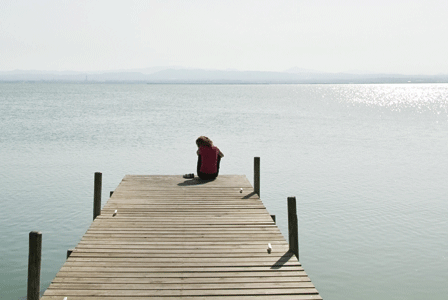
Noise has a negative impact on our health. Overcome the effects of noise pollution by cultivating your own quiet place.
Urbanization is a fact of Canadian life. A full 80 percent of Canadians live in cities and metropolitan areas—up from 67 percent just 50 years ago. If this trend persists our sprawling cities will continue to eat up our valleys and forests and, with it, our quiet spaces.
Environment experts predict that in this century we will suffer a shortage of water and silence. Countries around the world are studying the effects of noise, defined as unwanted sound. Our sonic environment affects all living organisms, and like other forms of pollution, noise pollution is harmful.
Most Canadian cities and towns have noise bylaws. Some countries, such as the Netherlands, have officially designated quiet areas. These areas must be at least several square kilometres, in which the loud noise caused from human activity cannot disturb the natural sounds in the area.
The cost of noise
Noise-induced and temporary hearing problems in adults and children are largely reversible, but long-term exposure leads to permanent hearing damage. Conversely, performance of simple, monotonous tasks may actually be improved by controlled noise, presumably by elevating alertness.
Noise research has its challenges because of complex networks of interrelated factors. Variables such as intensity, frequency, and complexity of sound duration (a dog barking may be a momentary distraction, but continuous barking is another thing entirely), and the meaning of the noise to the individual make it difficult to quantify adverse effects. Some people may love the “music” of crickets at dusk, while others are driven to madness by “that noise.”
Susceptible groups, including the elderly and young children, have different challenges than does the general population and, therefore, may be affected differently by exposure to noise.
Differences aside, occupational and environmental research, on which most noise data is based, indicates an obvious impact on our hearing. But noise is a health issue affecting more than just hearing.
Heart
A link between exposure to noise and hypertension (high blood pressure), heart rate, and peripheral vasoconstriction (constriction of blood vessels) has been indicated.
Stress
A sudden intense exposure to noise may stimulate catecholamine secretion (neurotransmitters and hormones such as epinephrine that are released in response to stress) as well as cortisol levels.
Sleep
Headaches, tenseness, and edginess have a direct association with high-noise areas. Sleep disturbance is also a consequence, which then impacts mood and performance during waking hours and is also linked to a risk of hypertension and ischemic heart disease.
Immunity
Research on the immune system shows an increased concentration of leukocytes in the blood of persons exposed to high levels of traffic noise, which then leads to lowered resistance to influenza and other diseases.
Recovery
High levels of noise near or inside hospitals appear to delay recovery and wound healing. There is (limited) evidence of a relationship between air-traffic noise exposure and pregnant women and low birth weight.
Learning
Young children appear to be particularly vulnerable to noise. When exposed to noise such as aircraft, studies show impairment with reading comprehension and long-term memory, decline in coping skills, reductions in motivation, and raised blood pressure. Daycare centres and schools should not be located near major sources of noise, such as highways and airports.
Mental health
Noise exposure creates annoyance, which leads to psychological symptoms such as depression, nervousness, anger, and fear; human error increases and helpfulness is reduced.
Social health
Diminished cognitive and social performance is associated with noise, and for some, intrusion of personal privacy is an issue.
Coping with noise
Reducing noise is often the last item people think of when asked what would help lessen stress in their lives. Noise is so insidious in our lives we accept it without thinking. We are so conditioned to noise we barely look up when an airplane crosses overhead, but when there is silence we stop what we are doing and listen. Silence grabs our attention.
Coping with noise is not a passive pursuit. In fact, active coping imparts the perception of control, thereby reducing overall stress. Establishing a time of stillness is not only nurturing to our soul and healing to our body, but also simply delicious.
Once we leave our noisy work environments behind, we enter our homes, close the door to the outside world, and drink in the peace and quiet. But is home all that peaceful—or quiet? If outside noise at home is bothersome, there are some alternatives to aggravation. Short of moving to a cemetery where the neighbours are quiet and the view is peaceful, there are other options to blocking outside noise:
- upgrade windows and doors
- improve sound barriers such as flooring and walls
- try a good set of comfy headphones
If the noise outside isn’t the problem, you might want to check for noise-makers inside your home. We may have escaped outside noises, but we’ve trapped them inside our homes! Noise levels in most homes are constant:
- TVs, radios, and other forms of communication are on for most of our waking hours.
- Our kitchens overflow with noise culprits such as blenders, coffee percolators, dishwashers, beepers, and ringers.
- Computer terminals emit low-level hums.
- Air conditioners, furnaces, hot water tanks, and refrigerators add to the cacophony of sound.
Noise stress, whether we feel it consciously or unconsciously, disconnects us from our inner selves and is toxic to the body. Imbalance occurs easily in this environment. It is important to balance a high-energy output with quiet times and meditation. Regular tuning in, into a deep relaxed space, lowers anxiety and heals the body.
Meditation and silence
It is worthwhile to consciously include silence in your daily life. Studies of meditation and silence have outlined long-term benefits when practised daily. Some of the benefits studied include
- decreased psychological distress
- alleviation of physical symptoms
- increased vitality
- decreased body pain
- improvement in reaction and focus
- greater orderliness of brain functioning, memory, and perception
- decrease in substance abuse
- decrease in stress hormones (adrenaline and cortisol)
- reduction in cholesterol
- overall enhancement of quality of life
When was the last time you sat in silence? If you are like most people, you probably can’t remember.
Have you had a moment when all the background noise in your home stopped: the refrigerator stopped its hum; the furnace stopped its drone? Silence … blessed silence … Did calmness immediately settle in, shoulders drop, jaw unclench, and the problems out there lose urgency?
If you’ve had this experience, it indicates the presence of stress or pressure held in your body that silence helps to alleviate. What can you do to create that sense of calm? Of course, it is not prudent to unplug freezers and furnaces, but there are other things we can do to get as close as possible to silence.
Indoor picnic
Spread a comforter on the floor by the fireplace, light some candles, and have a picnic. Encourage everyone in the household to participate. Incorporate this as a regular activity and watch the calmness and serenity of your household increase.
Turn off
Regularly turn off all unnecessary appliances and when replacing old or broken appliances, include noise levels in your shopping criteria.
Secret place
As children we had secret/quiet places. We whispered in our revered hideaway. Find or create your own space. It could even be your car parked in the garage. Be creative!
Walk
Nature offers us space to reconnect our senses in silence. We can find silence in the activities that we already do outdoors, for example, walking in our neighbourhood, parks, or other naturally pleasing areas. If you prefer to have music during your walks, choose soft, soothing music.
Listen into sound
Modern life is noisy and we would be hard pressed to find a truly noise-free environment. However, we can come to terms with sound if we focus not on finding that vacuum of silence outside of us, but on finding that place within.
Try listening into a sound, whether it be in natural or manmade.
- Sit quietly.
- Take several deep breaths.
- Listen to the sound.
- Be aware of the sounds around you; don’t shut them out.
- Listen deeper and deeper until you find the sound within the sound.
In the beginning that inner silence may feel like sadness. This is the ego feeling a loss of individuality, but stick with your practice. Eventually you will come to find the soothing and nurturing effects of this space regardless of the surrounding noise.
Inner silence is not about blocking out all sound. It is about coming into harmony with one’s true self.
|
The World Health Organization (WHO) considers noise levels at 80 to 90 decibels as hazardous. A general rule of thumb to avoid noise-induced hearing loss is to avoid noises that are too loud and too close, or that last too long. Above 80 decibels:
|
Indoor places of silence
These are just a few examples of the many sources of silence to be found in public and other indoor spaces all across the country:
- art galleries—Chapel Gallery, North Battleford, Saskatchewan
- museums—Canadian Museum of Nature, Ottawa, Ontario
- places of worship, churches, and mosques—Notre-Dame Basilica, Montreal, Quebec
- monasteries and abbeys—The Cistercian-Trappist Monastery of Our Lady of Calvary, Rogersville, New Brunswick (offers great facilities for retreats)
- libraries—Vancouver Public Library, Vancouver, BC
- spas—visit regularly
- infrared or steam saunas
- yoga or tai chi classes
- resorts focused on tranquility—Ocean Resort, Campbell River, BC (boasts the first driftwood labyrinth)
- silent retreats—Gampo Abbey, Pleasant Bay, Cape Breton, Nova Scotia
- virtual retreat—without leaving home or taking time off work you can learn breathing techniques, mindfulness, and practical suggestions via daily emails and Twitter.
- silent area of your workplace or home—even bathrooms will do
- biofeedback—recognize when you are in stress
- hypnosis—learn to de-stress from noise
- homeopathic remedies—use remedies that help with noise stress
What to do/think at your quiet place
- Be fully present in the moment. Be mindful.
- Follow your breath to calm and relax your body and mind.
- Practise any form of meditation/visualization—Finding Silence, James Roose-Evans (The History Press Ltd., 2009) or Meditation in a New York Minute, Mark Thornton (Sounds True Inc., 2004/06).
- Use mantras or affirmations?Peace,” “Calm,” “I love,” or “I am here.”
- Journal—daily journalling is therapeutic.
- Hold your pets—they remind us of our inner need for relaxation and restoration.
- Wake early and lay quietly for 10 to 15 minutes. Create a silent morning ritual.
- When in art galleries or libraries, pick a picture or book that is pleasing—contemplate; observe; no judgments.
Outdoor sources of tranquility
Nature gives us a greater awareness of the divine and there are many options to choose from—they may be just around the corner or worthy of a journey.
- snowshoe, cross-country ski, ice fish—Merritt, BC, for cross-country ski trails
- visit a Japanese garden—Hatley Park Japanese Garden, Victoria, BC
- walk through a Chinese garden—Dr. Sun Yat-Sen Classical Chinese Garden, Vancouver, BC
- visit parks and estuaries—look for some local to you
- go to the seashore—Peggy’s Cove, Halifax, Nova Scotia, to Tofino and Long Beach, Vancouver Island, BC
- get outdoors during or after a snowfall—snow muffles noise and adds soul-quenching serenity
- spend time in your own backyard (nighttime stargazing adds an extra dimension to silence)



